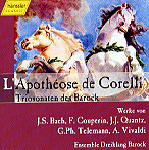First–this is a very well played and recorded program of Baroque trio sonatas, featuring works by several of the period’s most prominent composers. The “big” work is Couperin’s “programmatic suite” Le Parnasse, ou L’Apothéose de Corelli, having to do with Corelli asking the Muses for permission to join them, visiting Mount Parnassus, drinking inspiring waters from the fount of Hippocrene, falling asleep, and taking his place next to Apollo, the god of the Muses–after which he writes an expression of gratitude in the form of a fugue. It’s all very nice stuff, and these players convey the letter and spirit of the music beautifully.
The problem is the instrumentation, and the fact that it never varies throughout the disc. I’m not sure how many listeners would go to an hour-long concert to hear nothing but two recorders (with cello and harpsichord continuo) playing music only marginally varied in mood and style (I’ll probably hear from them all after this!). This is nothing against recorders nor against the music these first rate players have chosen. It’s just that the ear tends to tire of the timbres and registers of these instruments–and without any break, the sound wears thin sooner rather than later. In reality, trio sonatas are not usually intended for a specific set of instruments–and it’s quite common to vary the two “soloists” to include strings or other winds (such as oboe). Purely from a pleasurable listening point of view–which is primarily what recordings are about–that’s what should have happened here. I really did enjoy the Couperin (the “lullaby” movement is especially lovely) and, in later smaller doses of listening, the other pieces as well. Recorder people will particularly appreciate the fine playing–and if you really want to hear the Couperin, this is a perfectly good version. However, I prefer the one with violins, performed by Jordi Savall’s Hesperion XX (Naïve Astrée).
































